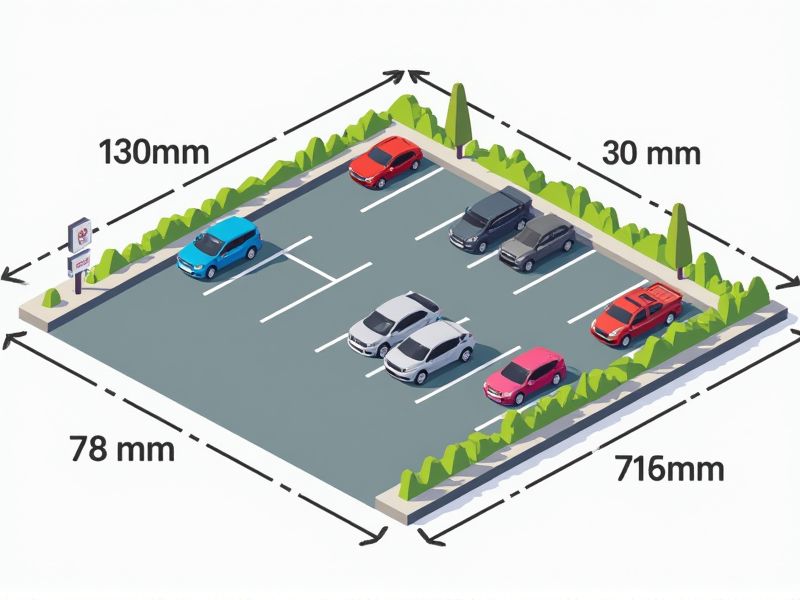
When designing or using a car parking lot, knowing standard dimensions can help ensure efficient use of space and safe maneuvering. Typically, a standard parking space for a passenger car is about 2.5 meters (8.2 feet) wide and 5 meters (16.4 feet) long. Aisle widths between rows are generally 6 to 7 meters (20 to 23 feet) for two-way traffic, allowing vehicles to enter and exit comfortably. These measurements may vary based on local regulations, but following these guidelines helps maximize both convenience and safety for drivers.
Compact Car Space Dimensions
Compact car spaces typically measure around 7.5 feet wide by 15 feet long, which is significantly smaller than standard parking spaces that average 8.5 feet wide by 18 feet long. These dimensions accommodate vehicles under 6 feet wide and 14-15 feet long, ensuring efficient use of space in urban areas where parking is limited. According to recent studies, utilizing compact spaces can increase parking lot capacity by approximately 25%, optimizing land use in high-demand environments. When designing or choosing a parking solution, consider your vehicle's size to maximize usability and adhere to local regulations.
Full-Size Car Space Dimensions
The standard dimensions for a full-size car parking space typically measure 9 feet wide by 18 feet long, offering ample room for vehicles measuring up to 6 feet in width and 16 feet in length. Many municipalities require these dimensions to ensure safe maneuverability and parking efficiency, accommodating personal vehicles and larger automobiles. Compliance with these space specifications promotes accessibility and can improve overall traffic flow within parking facilities. Familiarizing yourself with these parking dimensions can enhance your understanding of both public and private parking regulations.
Parallel Parking Dimensions
Parallel parking dimensions are crucial for optimizing space in a car parking lot, typically requiring a width of 8 to 9 feet and a length of 22 to 26 feet per vehicle. With these dimensions, you can accommodate a standard sedan while ensuring enough room for driver access and maneuverability. In densely populated urban areas, efficient parallel parking design can increase parking capacity by up to 30% compared to traditional perpendicular parking layouts. Proper signage and markings are essential to guide drivers in effectively utilizing these parallel spaces, enhancing overall parking lot functionality.
Handicap Parking Dimensions
Handicap parking dimensions are critical for accessibility compliance, ensuring spaces are at least 96 inches wide. This allows for adequate room for wheelchair users and those with mobility impairments. As per the Americans with Disabilities Act (ADA), there should be a designated number of accessible spaces, typically 1 accessible spot for every 25 total parking spaces. By prioritizing these dimensions, you enhance both the functionality and inclusivity of your parking lot.
Parking Lot Aisle Width
Parking lot aisle width typically ranges from 24 to 26 feet, ensuring smooth vehicle movement and safety. This width accommodates two-way traffic, allowing easy access to parking spaces while minimizing congestion. For single-aisle configurations, a width of around 12 to 14 feet is recommended, facilitating the maneuverability of larger vehicles. By adhering to these standards, you can enhance the overall efficiency and safety of your parking facility.
Ramp Slope And Design
The standard ramp slope for a car parking lot is typically designed at a maximum gradient of 1:10, ensuring safe access for vehicles while facilitating effective drainage. Adequate width of ramps, usually around 3 to 4 meters, allows for two-way traffic flow, enhancing overall efficiency. It's essential that the surface texture of the ramp is non-slip, featuring materials like concrete or asphalt with proper grading to prevent accidents. Proper signage and lighting should also be implemented to guide drivers safely, contributing to a well-organized and user-friendly parking environment.
Driveway And Entrance Dimensions
The standard dimensions for a car parking lot emphasize a minimum driveway width of 24 feet to ensure vehicles can navigate smoothly. Entrance widths typically range from 12 to 30 feet, accommodating different vehicle sizes and enhancing traffic flow. Aisle widths should be at least 12 feet for one-way traffic and 20 feet for two-way traffic, facilitating safe maneuverability. Adhering to these specifications can significantly reduce congestion and improve overall parking efficiency.
Marking And Signage Standards
The marking and signage standards for car parking lots are crucial for ensuring safety and efficient traffic flow. Clear demarcation of parking spaces, usually measuring 9 feet wide by 18 feet long, helps maximize capacity while maintaining accessibility. Signage must include essential information such as directional arrows, reserved spots, and handicap accessibility, typically positioned at a height of 5 to 7 feet for optimal visibility. Compliance with the Americans with Disabilities Act (ADA) requires accessible parking spaces to be at least 8 feet wide, allowing for appropriate vehicle maneuvering.
Proximity To Entrances And Exits
Proximity to entrances and exits is crucial in determining the overall efficiency and user experience of a car parking lot. A well-designed parking facility typically situates its entrances and exits within 100 to 300 feet of primary building access points, enhancing convenience for drivers and maximizing foot traffic. Research indicates that parking lots closer to main entry points can reduce average walk times to less than five minutes, promoting a seamless transition for visitors. Prioritizing this accessibility not only boosts customer satisfaction but can also increase the utilization rate of the parking space by up to 40%.
Lighting And Visibility Standards
In a car parking lot, effective lighting and visibility standards are crucial for safety and security. The recommended illumination level is between 2 to 5 foot-candles for parking areas, which enhances visibility for both drivers and pedestrians. Adequate lighting also reduces the risk of accidents and discourages criminal activity, fostering a safe environment. Ensure that lighting fixtures are positioned to minimize shadows and glare, allowing for clear sightlines throughout the lot.
